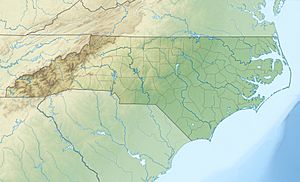Kelly Branch (Brown Creek tributary) facts for kids
Quick facts for kids Kelly Branch |
|
|---|---|
|
Location of Kelly Branch mouth
|
|
| Other name(s) | Tributary to Brown Creek |
| Country | United States |
| State | North Carolina |
| County | Anson |
| Physical characteristics | |
| Main source | divide between Kelly Branch and Lanes Creek about 0.25 miles south of Peachland, North Carolina 425 ft (130 m) 34°59′02″N 080°16′07″W / 34.98389°N 80.26861°W |
| River mouth | Brown Creek about 2 miles south of Peachland, North Carolina 269 ft (82 m) 34°57′26″N 080°14′59″W / 34.95722°N 80.24972°W |
| Length | 2.73 mi (4.39 km) |
| Basin features | |
| Progression | south |
| River system | Pee Dee River |
| Basin size | 7.18 square miles (18.6 km2) |
| Tributaries |
|
| Bridges | Lower White Store Road |
Kelly Branch is a small stream, also known as a tributary, located in Anson County, North Carolina. It begins just south of the town of Peachland, North Carolina. From there, it flows south until it joins a larger stream called Brown Creek. This stream is an important part of the local water system.
Contents
About Kelly Branch
Kelly Branch is a small but important waterway in Anson County. It is considered a "tributary" because it flows into a larger body of water. In this case, it flows into Brown Creek. Brown Creek then flows into the even larger Pee Dee River. This means Kelly Branch is part of a much bigger river system.
Where Does Kelly Branch Start?
The journey of Kelly Branch begins about 0.25 miles (0.4 kilometers) south of Peachland, North Carolina. This starting point is called its "source." At its source, the land is about 425 feet (130 meters) above sea level. This is where the water first collects and starts to flow.
How Long is Kelly Branch?
From its beginning near Peachland, Kelly Branch flows for about 2.73 miles (4.4 kilometers). That's roughly the distance you might walk or bike in a short trip! It's not a very long stream, but every stream, big or small, plays a role in the environment.
Where Does Kelly Branch End?
After its journey south, Kelly Branch meets Brown Creek. This meeting point is called its "mouth." The mouth of Kelly Branch is about 2 miles (3.2 kilometers) south of Peachland. At this point, the elevation is lower, around 269 feet (82 meters) above sea level. The water from Kelly Branch then becomes part of Brown Creek's flow.
What is a Watershed?
The area of land that drains water into Kelly Branch is called its watershed. For Kelly Branch, this watershed covers about 7.18 square miles (18.6 square kilometers). Think of it like a giant funnel. All the rain and runoff that falls within this area eventually makes its way into Kelly Branch.
Land Use in the Watershed
The land around Kelly Branch is used for different things. About 55% of the watershed is covered by forests. These forests are important for wildlife and help keep the water clean. Another 41% of the land is used for farming, which is called agricultural land. The rest of the land has other uses. This mix of forests and farms shows how humans and nature share the land around the stream.
Water Flow and Tributaries
The average amount of water flowing out of Kelly Branch into Brown Creek is about 8.20 cubic feet per second (0.23 cubic meters per second). This is like saying that every second, a volume of water equal to about 60 gallons flows out!
Kelly Branch also has its own smaller streams that flow into it. These are called "tributaries" too. On the right side of Kelly Branch, there is a stream called Key Branch that joins it. There are also other unnamed small streams that add water to Kelly Branch.
Bridges Over Kelly Branch
Even small streams like Kelly Branch have roads that cross over them. One of the bridges that crosses Kelly Branch is on Lower White Store Road. Bridges help people travel easily while allowing the stream to flow freely underneath.
Importance of Small Streams
Small streams like Kelly Branch are very important for the environment. They help carry water from the land to larger rivers and eventually to the ocean. They also provide homes for many different plants and animals. Keeping these small streams healthy is key to keeping the entire river system healthy. They are like the veins of the land, carrying life-giving water.


